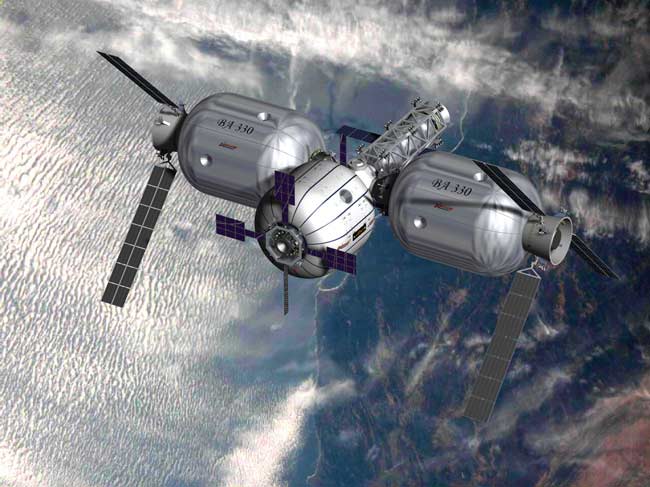NASA's Far-Out New Plans

By all accounts, President Barack Obama's new proposal forNASA's future is a game-changer.
The plan calls for abandoning the status quo ? including theConstellation plan to rocket humans back to the moon ? and investing instead ininnovative new projects. Here are some of the far-out ideas that could come topass under the new NASAplan:
Faster space propulsion
Obama proposed devoting some of NASA's budget towarddeveloping new spaceflight technologies, including innovative methods of space propulsion.The plans specifically call for building faster ways of moving through space sothat future manned trips might not take as long, require as many resources, orexpose astronauts to so much space radiation.
"Imagine trips to Mars that take weeks instead ofnearly a year; people fanning out across the inner solar system, exploring themoon, asteroids and Mars nearly simultaneously in a steady stream of firsts,"NASA administrator Charles Bolden said Monday in a briefing on the new plans.
Commercial spaceships
One of the most striking shifts in the proposed vision is toabandon NASA's current attempts to build a new vehicle to carry humans intospace, and instead encourage private companies to develop this technology. NASAwould then rely on commercialspaceships to ferry astronauts to the space station and low-Earth orbit.
Get the Space.com Newsletter
Breaking space news, the latest updates on rocket launches, skywatching events and more!
"Because it's companies doing these things and they'recompeting against each other, the competition and fixed prices of contracts aregoing to drive a much higher level of efficiency and innovation than would havehappened if the government just plodded along on its own," said CornellUniversity planetary scientist Jim Bell, president of the non-profit Planetary Society,a space-interest organization.
Two companies, Space Exploration Technologies (SpaceX) inCalifornia and Orbital Sciences Corp. of Virginia, currently have contractsworth a combined $3.5 billion to provide unmanned cargo shipments to theInternational Space Station for NASA.
Space tourism and colonization
One of the possible consequences of new commercial spacevehicles and new propulsion mechanisms is the chance that human civilians couldtravel to space in large numbers for the first time. That means that spacevacations and moon hotels may not be a mere pipe dream anymore.
"I am excited to think that the development ofcommercial capabilities to send humans into low earth orbit will likely resultin so many more earthlings being able to experience the transformative power ofspaceflight," Apollo 11 astronaut Buzz Aldrin said in a statement.
In his comments, Bolden echoed this sentiment.
"Imagine enabling hundreds, even thousands of people tovisit or live in low-Earth orbit, while NASA firmly focuses its gaze on thecosmic horizon beyond Earth," he said.
Space gas stations
Orbital fuel depots are also set to be investigated in thenew vision. Such supply stations would allow spacecraft to launch to low-Earthorbit, then rendezvous with a fuel container and load up on the extra juice theyneed to travel further.
Space gas stations could prove pivotal to manned trips toMars or beyond, because reloading once in space would allow spacecraft to takeon much more fuel than if they were forced to launch from Earth with all thepropellant they needed.
Inflatable space houses
Another new technology mentioned in the plans for NASA is inflatablespace modules. Inflatable habitats are very appealing because they would bevery light to launch, but could potentially provide a flexible and usefulframework for building rooms, both in orbit and on the moon or other planets.
Now that the lifetime of the International Space Station hasbeen extended to 2020, the orbiting laboratory could possibly grow beyondcurrent plans. It's not out of the question that new types of space modules,including inflatable rooms, could be added to the station before its tenure isup.
One company, the Las Vegas, Nev.-based firm BigelowAerospace, has already launched two inflatable space station module prototypesinto orbit. They?re still up there today.
Green aviation
The new vision also calls for NASA to invest in developingmore environmentally friendly modes of air and space travel. The budgetproposal allocates $20 million per year for NASA's green aviation program. Researchprograms will focus on reducing aircraft fuel needs, noise and carbonemissions.
"These investments will enable safer and cleaner airtravel in the future," NASA deputy administrator Lori Garver said Monday.
- POLL: Is Abandoning NASA's Moon Plan the Right Choice?
- Commercial Spaceflight: Big Decade, Big Future
- Video - Star Trek's Warp Drive: Are We There Yet?
Join our Space Forums to keep talking space on the latest missions, night sky and more! And if you have a news tip, correction or comment, let us know at: community@space.com.

Clara Moskowitz is a science and space writer who joined the Space.com team in 2008 and served as Assistant Managing Editor from 2011 to 2013. Clara has a bachelor's degree in astronomy and physics from Wesleyan University, and a graduate certificate in science writing from the University of California, Santa Cruz. She covers everything from astronomy to human spaceflight and once aced a NASTAR suborbital spaceflight training program for space missions. Clara is currently Associate Editor of Scientific American. To see her latest project is, follow Clara on Twitter.









